
I’m a self taught baker. I love trying new recipes, watching tutorials, and reading books to learn as much as I can about how to make the best bread possible.
But the most valuable information I’ve gleaned comes from trial and error. I’ve made a lot of bread baking mistakes during my experimentation, and here are some of the biggest ones I’ve made so far.
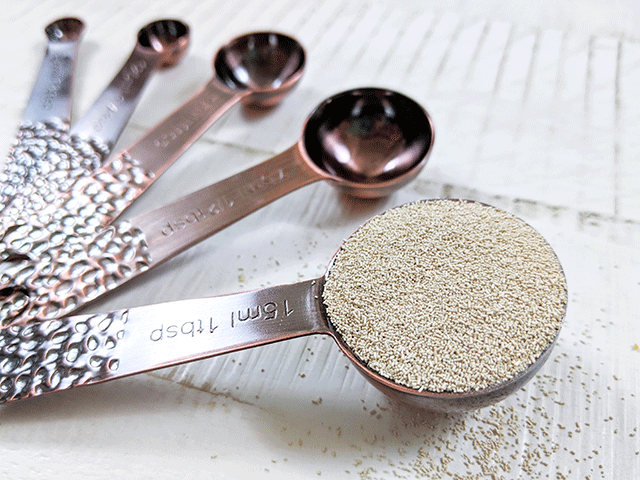
1. Killing the Yeast
Yeast is the secret to fluffy, tasty bread. It makes bread rise and lends flavor to an otherwise bland recipe.
However, yeast can be tricky to deal with. If you store it at improper temperatures, you’ll kill it. If you use hot water while baking, you’ll kill it. And if you add salt to it too soon, you’ll kill it.
And dead yeast means flat, dense bricks rather than beautiful loaves.
How to Make the Most of Your Yeast
If you want to keep your yeast alive and thriving, here’s what you’ll need to do:
- Store your yeast in the fridge – Ideally, you should store yeast between 33 degrees and 38 degrees Fahrenheit, the average temperature of a typical fridge. Although you could store your yeast in the freezer, the extra cold temperatures in your freezer can cause cell damage to your yeast, resulting in dead yeast or damaged yeast that won’t rise as effectively.
- Proof your yeast before baking – Unopened, vacuum-sealed yeast can last on a cool pantry shelf or in a refrigerator for up to 2 years. However, once you’ve opened your yeast, you should ideally use it within 4 to 6 months. If you’re not sure how old your yeast is, proof your yeast before baking. Add water to your yeast and let it sit for 10 to 15 minutes. It should bloom and foam nicely. If you don’t see any activity, throw it out.
- Use warm water, not hot, while baking – Yeast grows best in a warm environment. If the water is too cold, it won’t activate. If it’s too hot, it will die. Use a thermometer to test your water before adding it to the yeast. Keep temperatures between 90 degrees and 130 degrees Fahrenheit.
Keep in mind that these tips apply to commercial dry active yeast, not the yeast you commonly find in homemade sourdough starters. If you make a lot of sourdough bread baking mistakes, check out my post on Commonly Asked Sourdough Starter Questions.
2. Over or Under Proofing Dough
Yeast needs time to work its magic and let your bread rise. However, timing your rise can be a little tricky. If you let your bread proof too little, your bread will stay flat and dense. If you let your bread proof too long, you’ll exhaust your yeast and your bread will collapse.
Fortunately, you can use these tips to optimize your bread dough and get the fluffiest, airiest bread possible:
- Try the poke test – This method works best with lower hydration dough. As your dough proofs, give it a poke, letting your finger sink up to the first knuckle. If the dough springs back quickly, it needs to proof longer. Dough that collapses has proofed for too long. If it fills back in slowly and holds some of its shape, go ahead and bake it.
- Gently stretch the dough – As your dough rises and develops its gluten structure, it should become more elastic and less slack. Gently stretch your dough without breaking it. If you can stretch it six inches, or enough to see light through the dough (aka the window pane method), it’s proofed long enough.
- Mark and measure the volume – High hydration dough doesn’t follow the other two rules. It’s too wet and slack to gauge via poking or stretching. However, you can still watch and measure its progress. Use a dry erase marker on the outside of a glass bowl to mark its starting point. Then measure and mark a line on the bowl that indicates the doubling point. Or, use a container that comes with measurements already. When your dough rises to meet the second line, go ahead and work with it.
Keep in mind that even experienced bakers struggle with timing on occasion. You’ll need to practice again and again to get a feel for your dough.
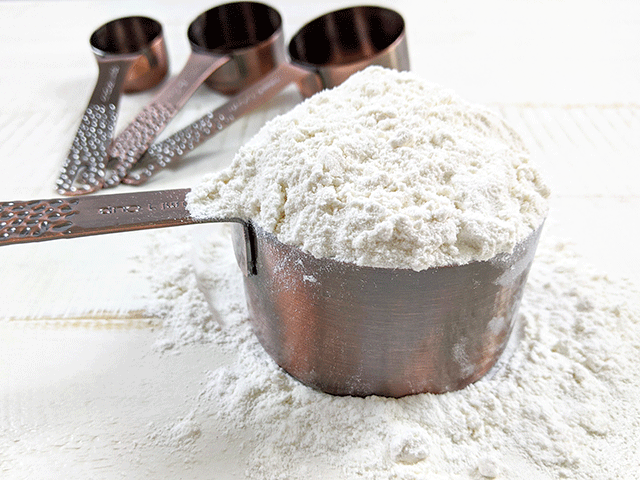
3. Using Too Much Flour
Whether you want to make rye sandwich bread, whole wheat boules, or cinnamon sugar sweet breads, flour will always be your key ingredient. You need flour for mixing, flour for sprinkling, and flour for unsticking. Without flour, you clearly won’t be making any bread.
However, you can have too much of a good thing when making bread. Too much flour will make your bread dense, dry, and crumbly. If you use too much flour, your dough will be difficult to work with and may even fall apart as you knead it.
So how can you keep your flour ratios in check?
- Stir your flour before measuring – Flour packs easily, and if your flour has sat in its packaging for a while, you can bet that it has settled. When baking, your flour should be light and airy, so give it a stir before you scoop it with a measuring cup. Then use a flat knife to level your flour before adding it to your dough.
- Use a sifter – Many flours come pre-sifted for your convenience. But even pre-sifted flour can settle, and measuring cups and spoons disperse flour in clumps and piles. With a fine-mesh sifter or sieve, you can sprinkle flour evenly over your dough in controlled amounts.
- Don’t be afraid to get sticky – High hydration dough, in particular, is notorious for sticking to everything. It’ll stick to your dough scraper, to your fingers, and to your spoons. If you use flour to avoid getting sticky, you’ll upset your flour to water ratio in the dough. Instead of using flour while you knead, try using wetting your hands with water or spraying some butter or oil on your kneading surface.
While you can definitely use flour throughout your bread baking process, keep a wary eye on how much you use and when you use. A little caution will help you avoid one of the most common bread baking mistakes beginning bakers make.
4. Using the Wrong Flour Type
Bread comes in as many flavors and colors as you can imagine. From sweet to sour, whole wheat to rye to barley, you can mix and match flours and flavors to get a bread that tickles your taste buds in amazing and unique ways.
But if you are new to baking, you might want to stick to the recipe rather than substituting one flour for another.
Different flours behave differently during the baking process. Whole wheat flour soaks up more water than all-purpose flour. All-purpose flour has less protein than bread flour and takes longer to develop gluten. Rice flour lacks gluten altogether and requires a bonding ingredient to hold it together.
Not sure which flour type to use in a recipe? Here are a few general rules to follow:
- Remember that strong flour = bread flour – Strong white flour is another name for bread flour. This flour type has 12- to 13-percent protein content, making it ideal for artisan breads that require shaping. If you don’t have bread flour, you can use all-purpose flour. But you’ll need to work with the dough more and use a little less water.
- Make your own self-rising flour – Self-rising flour traditionally uses a lower-protein version of all-purpose flour. However, you can make your own by adding 1 1/2 teaspoons baking powder and 1/4 teaspoon salt to every cup of all-purpose flour. But because all-purpose has a higher protein content than self-rising, you’ll need to add a little more water to the dough as well.
- White whole wheat is not the same as white flour– White whole wheat offers 13 percent protein, putting it in the middle of whole wheat flour and all-purpose. If you want the taste of and color of whole wheat but the workability of all-purpose, white whole wheat is a good option. Although you can easily substitute white whole wheat for wheat flour cup for cup, you’ll have to substitute it for half the amount of all-purpose flour in your recipe.
For your convenience, you can sort recipes on my blog based on the flour type you have. Simply head up to the navigation bar and explore what’s there. Each of my recipes has a secrets to success section so you can avoid common bread baking mistakes.
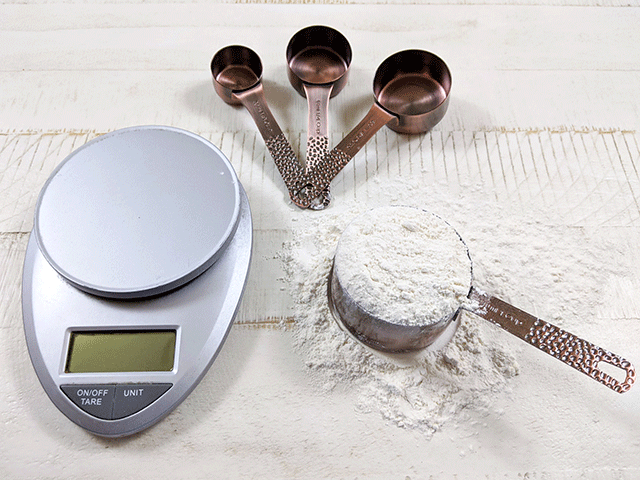
5. Measuring by Volume Instead of Weight
Many recipes rely on cups and spoons for measuring ingredients. However, measuring cups are not as precise as they might seem. Although they may give you the approximate amount you want, they may give you inconsistent results in your baking – with too much flour in one recipe or too little in another.
If you want to make great bread again and again, you’ll need to use more precise and consistent measurements, and here’s how:
- Use a kitchen scale – Kitchen scales don’t have to be expensive. In fact, you can find one on Amazon for under $15. And Walmart sells them for as little as $13. With a scale, you can weigh your ingredients before you bake, so you’ll get the same results every time.
- Check your scale for accuracy – Once you have a scale, make sure it’s accurate. Even a new scale can be a little off and that will affect your baking. Test your scale by weighing a few coins. A new penny should weigh 2.5 grams, and two pennies should weigh 5 grams.
- Look for recipes that offer weight over volume – Many recipes, especially European sites, provide weight measurements rather than volume, and these will make it easier whenever you want to make a consistently good batch of bread. However, if you don’t have access to the weight, you might need to do a little googling for some conversion rates. The average cup of flour weighs approximately 4 1/4 ounces or 120 grams. The average cup of sugar weighs approximately 7 ounces or 198 grams.
To help you out, I try to provide both volume and weight measurements whenever I post my recipes. With my step-by-step instructions and pictures, you can avoid common bread baking mistakes whenever you bake my breads.
How Have You Improved?
I’ve improved quite a bit of the last few years of baking, but I’m still learning new things all the time. I’d love to hear about your baking experiences, tips, and tricks. Feel free to share them in the comment section below. Your advice can help others avoid common bread baking mistakes.

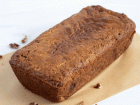

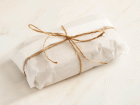
just started and today was my 2nd attempt at dinner rolls. I followed the instructions to the letter including weighing the ingredients. Everything looked great but after an hour rolls still did not rise much at all. I think the problem was I heated the mild to only 90 degrees and when I transferred it to my metal bowl, it became too cool to activate so my next attempt I will heat the milk to 110 degrees and then wait about 5 minutes before I add my flour. I will keep my fingers crossed.
Thanks for letting me know 🙂 Good luck with your baking!
Making the Friendship Bread. Do you store the starter bag at room temperature or in the refrigerator?
Keep it at room temperature if possible!